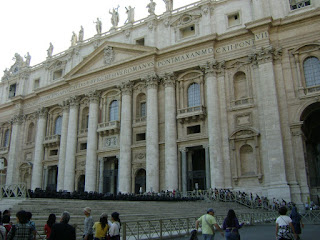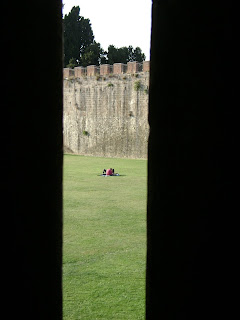On Tuesday, the last day in September, we took a 3 hour train ride from Pisa Centrale to Rome Termini. We used our Roma passes to ride the Metro to the Furio Camillo station, which was just 1/2 mile from the place we stayed, at Via Camillo Porzio 27. We rented a room in a private residence, on the south side of the city, near the Catacombs. It was called Appian Garden, probably because it is near the Appian Way, the ancient Roman road that was built in 312 BC and is still in use today.
It is one of the few homes in Rome with a yard. It once belonged to a farmer who sold the surrounding land to developers, who built apartments. The yard was fenced, so we had two keys: one for the gate, and another for the door to our room. It was a very small room, just barely enough space for the bed, two chairs and a clothes rack. Our bathroom, pictured below, was private and ensuite, and very interesting. Notice the handheld shower on the right and the drain in the floor? This was the shower/bathroom combo!
We were very tired, so we soon settled in to our cosy little room and got a good night's sleep.
The next day we got up, strapped on our Rick Steves money belts, and set off to see Rome. But first we stopped at a little Bar on the corner for breakfast. No one there spoke English, so we asked for "Due cappuccini, per favore." A nice lady behind the pastry bar gestured to the table in the corner, inviting us to sit, then brought us some cookies to have with our coffee. This is a typical Italian breakfast -- coffee and a pastry. Italians take their coffee very strong. Espresso is typically served in a very small demitasse cup, or sometimes in a shot glass. Some drink it quickly while standing at the bar. Cappuccino is served in a larger cup (about half full of coffee) that is topped off with hot, steamed frothy milk. If the bartender knows you are American, he may offer you some sugar for your coffee. We liked this bar so much we had breakfast there every morning.
Our first stop was the Vatican Museum and St. Peter's Basilica. Here I am leaning against the outside of the Vatican Wall. Vatican City is actually a tiny independent country that includes the Vatican Museum, the Sistine Chapel, and St. Peter's Basilica.

Here I am in St. Peter's Square, where a huge crowd had gathered earlier that day to see the Pope.

The Vatican itself was an imposing structure. Visitors lined up to get inside.
Swiss Guards keep an eye on things. They were all business and not too interested in posing for photos. Notice the cobblestone road. They filmed part of the movie The DaVinci Code on this street!

Garold got out his MP3 Player with the Rick Steve's audio tapes that Laura downloaded for him. After a few tries he got the hang of it and looked like a pro.

The halls of the Vatican Museum are lined with art--4 miles of it. It was a bit overwhelming.

Even the ceilings were works of art.
The Madonna and Child is a recurring theme in so much of the art in Italy.

But they also have their ancient Roman Gods.

It was amazing to see how life-like a marble statue can look. Here is a Roman mother nursing her child.

In this painting, women appear to be changing a baby's diaper.

The mural below is called
School of Athens and was painted around the same time Michelangelo painted the Sistine Chapel ceiling--1508-1512. It shows Plato (dressed in orange/red) and Aristotle (dressed in blue) in the center. Archimedes is the man in the foreground who is leaning over and pointing to a slate. Behind him and to the right the young man who is looking at you is the artist, Raphael. Notice the beautiful inlaid marble floor.

The building in Raphael's mural resembles the present day Vatican. Below is a photo I took of a Swiss Guard at one of the Vatican entrances in October of 2008.

Everything was beautiful, even the view from this window was exceptional.

Here I am in one of the great long halls, with its beautiful inlaid marble floors. Notice the lack of benches anywhere....we got pretty tired and quickly fell behind the crowd.

We also saw the Sistine Chapel, which is located inside the Vatican Museum. Michelangelo painted the ceiling himself over a period of 4 years for Pope Julius II, who according to a letter written by the artist in 1523, gave him permission to "make what I wanted, whatever pleased me." Because it is a holy place, Vatican employees periodically called out "silenzio!" Photos were not permitted, but here is small photo that I retrieved from Yahoo Images. The impact of this room cannot be communicated in photos or in words. You have to experience it for yourself to appreciate the power of this creation.

Next we went to St. Peter's Basilica. Just inside the door, to the right, Michelangelo's Pieta is on display behind bullet proof glass. He sculpted this when he was only 24 years old, and it is the only work he ever signed. This is the most beautiful work of art I have ever seen. I saw it for the first time as a black and white photo in my college Humanities textbook more than 40 years ago, but I took the photo below myself on 10/1/08.

This is a monument to Pope Alexander VII (1655-1667). It was Bernini's last great masterpiece (he was 80 when he did this), and is located behind the Main Altar and to the left, near the part of the church where they still hold daily masses for anyone who wishes to attend.

Most of the popes are buried in St. Peter's. This did not click for me until I saw the tomb of Pope John XXIII, who died in 1963. His body, which can be seen inside the lighted coffin, is very well preserved!

Peter, one of the original 12 apostles, was crucified here shortly after the Great Fire of Rome, in the year 64 A.D. In 1942, the bones of a male person were found in the excavations beneath St. Peters Basilica. A forensic examination more than 20 years later found them to be a male of about 61 years of age from the first century. In 1968 Pope Paul VI declared them to be the relics of Saint Peter. These are now located under the main altar, pictured below, under Bernini's Baldacchino.

Here is a closer view of the Baldacchino, a 7-story bronze canopy over the main altar.

Because we were in St. Peters in the late afternoon, we were treated to this spectacular light show. The circular window surrounded by gold starbursts (in the center) was designed by Bernini and is directly above the Throne of St. Peter. It is called the Dove Window, because there is a dove, which represents the Holy Spirit, in the very center of the glass.

These people were gathering for the 5:00 mass that took place in front of St. Peter's throne and Bernini's starburst window.

Notice the dark wooden cabinets located to the left and to the right of the columns in the photo above. Below is a closer view of one of them. We think this is where the Priest hears confessions, but we're not sure.


 He was so happy to be here he gave it a thumbs up!
He was so happy to be here he gave it a thumbs up!

 Rome is full of ruins. Here you see them simply lying about while people casually walk by.
Rome is full of ruins. Here you see them simply lying about while people casually walk by. They continue to dig, and they keep finding more.
They continue to dig, and they keep finding more. Here's Garold in what's left of the Roman Forum. Those cobblestones have been there for centuries. Imagine Roman Senators wearing togas and sandles strolling down this street discussing politics and philosophy.
Here's Garold in what's left of the Roman Forum. Those cobblestones have been there for centuries. Imagine Roman Senators wearing togas and sandles strolling down this street discussing politics and philosophy. Julius Caesar's body was burned here after his assassination in 44 B.C.
Julius Caesar's body was burned here after his assassination in 44 B.C. People still leave flowers to honor him. He walked right by this spot on the very day he was assassinated, and was warned to "Beware the Ides of March!"
People still leave flowers to honor him. He walked right by this spot on the very day he was assassinated, and was warned to "Beware the Ides of March!"

 Here I am in St. Peter's Square, where a huge crowd had gathered earlier that day to see the Pope.
Here I am in St. Peter's Square, where a huge crowd had gathered earlier that day to see the Pope. 

















 Here is a closer view of the Baldacchino, a 7-story bronze canopy over the main altar.
Here is a closer view of the Baldacchino, a 7-story bronze canopy over the main altar.






 This is the view from the terrace that was on our floor. There were tables and chairs in case you wanted to hang out and have a cappuccino. At this time Garold wasn't yet hooked on them. But stay tuned: that will happen very soon!
This is the view from the terrace that was on our floor. There were tables and chairs in case you wanted to hang out and have a cappuccino. At this time Garold wasn't yet hooked on them. But stay tuned: that will happen very soon!  Of course, a visit to Pisa would not be complete without the obligatory photos of the turiste holding up the leaning tower! Garold thought he could do it with just one finger.
Of course, a visit to Pisa would not be complete without the obligatory photos of the turiste holding up the leaning tower! Garold thought he could do it with just one finger. 


 We got pretty tired pretty quickly, so when we saw a park, we took advantage of the opportunity to sit down for a while. Children in Italy like to race their bikes just like the adults like to race their cars and Vespas!
We got pretty tired pretty quickly, so when we saw a park, we took advantage of the opportunity to sit down for a while. Children in Italy like to race their bikes just like the adults like to race their cars and Vespas!





